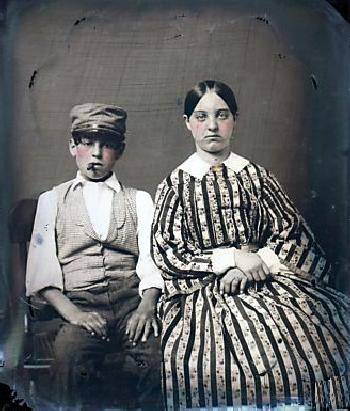
Photography: Ambrotype--Colored Glass

Figure 1.--Here is an example of a ruby ambrotype. It is undated, but was probably taken in the late-1850s. The boy looks to be a teenagr. He wears a cap, vest and rolled up sleeves. Note the cigar. He is sitting next to a slightly older teenage girl with a stylish striped dress, gold broach and a ring on her left hand. I am guessing she is his sister as they both seem too young to be husband and wife. Their eyes show no emotion. The case has R. N. Kelly, Cor. 5th & Coates, Philad' pressed into the velvet padding. Click on the imge for an enlargement.
|
|
An ambrotype was normlly done with clear, colorless glass to create the negative. The back was normally painted black. Other options were to use a black cloth or other blackened objects like carbord to place in the frame behind the negative. Some Ambrotypists offered colored class Ambros. The most popular was red tinted glass. These were called ruby Ambrotypess. With ruby Ambros, the black background or paint was not required as the red tint made the glass naturally darker. Some Amrotypists also offered dark green glass, but this was much less common. We do not note the term emerald Ambrotype being used, but authors sometimes refer to emerald-tinted glass. The ruby Ambros gave a warmer appeaeance and also hinted at flesh tones. This makes ruby Ambros especially popular among modern collectors. The ruby Ambros can often not be identified with any surity unless you take the Ambro plate out of its protective case. Holding it up to a light allows you to look through the glass instead of viewing reflected light.
Clear Glass
An ambrotype was normlly done with clear, colorless glass to create the negative. The back was normally painted black. Other options were to use a black cloth or other blackened objects like carbord to place in the frame behind the negative.
Colored Glass
Some Ambrotypists offered colored class Ambros. The most common were ruby red ambros, but there were also emerald ambros.
Ruby red ambros
The most popular was red tinted glass. These were called ruby Ambrotypess. With ruby Ambros, the black background or paint was not required as the red tint made the glass naturally darker. The ruby Ambros gave a warmer appeaeance and also hinted at flesh tones. This makes ruby Ambros especially popular among modern collectors. The ruby Ambros can often not be identified with any surity unless you take the Ambro plate out of its protective case. Holding it up to a light allows you to look through the glass instead of viewing reflected light. A good example is an unidentified younger boy. We also notice an
unidentified America youth in the 1850s.
Emerald ambros
Some Amrotypists also offered dark green glass, but this was much less common. We do not note the term emerald Ambrotype being used, but authors sometimes refer to emerald-tinted glass. We have found very few examples of these emerals ambros. They were not as common as the ruby ambros that gave a warmer, more appealing look. One example is an unidentified family.
HBC

Navigate the Boys' Historical Clothing Web Site:
[Return to: Main ambrotype page]
[Return to: Main ordinry boys 1850s page]
[Introduction]
[Activities]
[Biographies]
[Chronology]
[Clothing styles]
[Countries]
[Bibliographies]
[Contributions]
[FAQs]
[Glossaries]
[Images]
[Links]
[Registration]
[Tools]
[Boys' Clothing Home]
Navigate the Boys' Historical Clothing Web Site:
[Sailor suits]
[Sailor hats]
[Buster Brown suits]
[Eton suits]
[Rompers]
[Tunics]
[Smocks]
[Pinafores]
Created: 5:45 PM 11/22/2008
Last updated: 2:05 AM 1/22/2010



